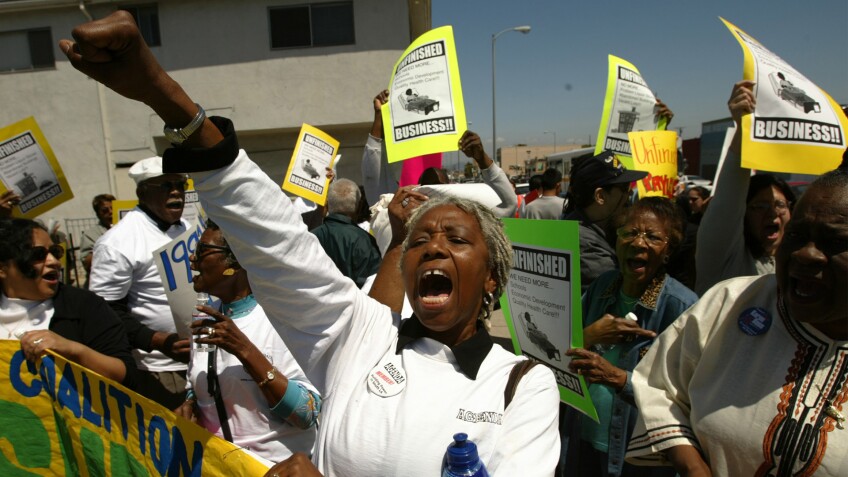Looking Forward, Not Back: How South Los Angeles is the Future

Twenty five years ago, Los Angeles exploded in the worst urban civil unrest in contemporary American history.
Ground zero for the social upheaval was South L.A., an area battered by deindustrialization and job loss, wracked by a crack epidemic and gang warfare, and frustrated by policing practices that best resembled those of an occupying force. Added to the brew was a rapid demographic shift — from 80 percent Black in 1970 to nearly half Latino by 1992 — that strained community institutions.
Flash forward to today and some might surmise that little has changed: South L.A. still boasts unemployment and poverty rates far above the county average, police-community relations are improved but remain fraught with concerns over excessive force, and the demographic denouement seems complete, with some older Black residents wondering about their place in an area that is now two-thirds Latino.
But there are three important new facts on the ground.
The first is that the characterization of multi-racial tension that may have once aptly described South L.A. is no longer entirely appropriate. An earlier generation of Latino immigrants did more or less “shut in and shut out” from civic life when they first arrived — partly because of anti-Black attitudes they brought from home countries, partly because they arrived in a time or turmoil and chaos, and partly because newly arrived immigrants just tend to focus on family and work.
But a second generation of native-born Latino youth has grown up with Black friends, neighbors, and classmates. They learned their civil rights history in schools where the focus was more on Martin Luther King than on the school walkouts in East L.A. — and they embrace Kendrick Lamar as well as their parents’ ranchera. Meanwhile, both African American and Latino residents see significant common ground in issues like over-incarceration, inadequate education, and poor job prospects.
This is, in part, because of a second new reality: the growth of community-based institutions with multi-racial bridge-building baked into their organizational DNA. For example, South L.A.-based SCOPE has brought together Black and Brown residents to fight for green jobs and forge a nationally recognized model for voter engagement. Community Coalition has trained multi-cultural youth leadership to fight for better schools (with its founder Karen Bass going on to Congress, and her successor, Marqueece Harris-Dawson, to the L.A. City Council), while CADRE and others have sought to engage parents in education reform.
The new maturity and commitment to weaving together communities was demonstrated in 2015 when a wide range of South L.A. advocates, workforce developers, and service providers came together to compete for a Promise Zone designation from Washington with a plan based on transit lines — partly because that linked the Blacker west side and the more Latino east side. Their proposal, intended to move South L.A. up the queue for federal dollars, was initially rejected by the Department of Housing and Urban Development (HUD). Demonstrating resilience, smarts, and creativity: the advocates soon figured out the problem: HUD was gauging housing need based on the vacancy typical of Detroit and not the immigrant overcrowding occurring in South L.A. So they invited the HUD secretary to visit, lobbied to change the rules, and wound up with a winning proposal that was ranked second best in the country in 2016.

The experience and its promise of new federal dollars also speaks to a third new fact: after all these years of challenges, South L.A. is suddenly “hot.” The extension of rail, particularly the Expo Line to Santa Monica, the emergence of downtown as a center for retail, dining, and loft living, and the expansion of the University of Southern California, are bringing both a new dynamism and new threats.
This is, after all, an area in which the tattered boulevards — stark symbols of public and corporate disinvestment — have long stood in sharp contrast to the pride of place evident in well-tended single family homes in the nearby residential neighborhoods. With long-awaited investments finally occurring, worries about gentrification — a distant concern in 1992 — are suddenly imminent.
What does this mean going forward?
First, the fight against displacement will be increasingly important to the future of South L.A. Any turnaround should be enjoyed by those who have stuck through the hard times — and this will require strategies to stabilize rents and expand affordable housing.
Second, insuring that the turnaround delivers to local residents requires a commitment to local hiring and job training. Given the legacy of over incarceration, this means strong efforts to incorporate those exiting the criminal justice system, as well as the sort of outreach efforts conducted by groups like the Black Workers Center.
Third, the robust movement that organizations have developed will be key to moving policy and practice. Like the South L.A. residents they represent, these groups evidence pride in their neighborhoods, an awareness of the challenges, and a sense of what they want for their future.
Twenty five years ago, the civil unrest revealed to the world the ways in which injustice and disinvestment can contribute to widespread rage. Since then, South L.A. has been a laboratory for holistic approaches that weave together concerns and communities — and having lagged in the city-wide recovery, it may be one of the last best places to show the city as a whole how development can be done without displacement.
Today, the future of L.A. — and urban America — is being forged in South L.A.
We invite you to join us this Saturday April 29 at 10:30am at the intersection of Florence and Normandie as we march to Future Fest, a community festival and rally celebrating our collective vision for the next 25 years. Please visit http://www.southlaisthefuture.com for more details.





